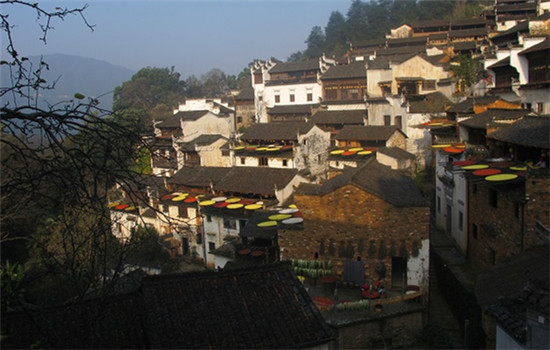
The Hui-style architecture is marked by white walls and black-tiled roofs. (Photo by Rosemary Bolger/chinadaily.com.cn)
Huangling sets expectations high with its claim to be "the most beautiful countryside in China" plastered across its promotional material. Such a big statement may rouse the skeptics, but it's better to leave those quibbles at the cable car door and simply enjoy the view.
The village has been turned into a living museum and its owner the Wuyuan Countryside Development Company does not pretend otherwise. The private company's largest shareholder Wu Xiangyang saw the location's potential as a tourism attraction 18 years ago. At that stage, there were less than 600 people living in rundown houses.
"Most people want to go outside (the village) to work so few people were left in the village. If we waited another 5 to 10 years, it would have soon vanished," Wu says.
The company has poured large sums into repairing and restoring the Hui-style houses known for their solid white walls (residents believed a dark room was more peaceful) and black-tiled roofs.

Residents have paid a high price. They have been moved to an apartment complex at the base of the mountain, and their homes turned into boutique accommodation, fetching up to 5,000 yuan a night (although many rooms are available for much less). But in return they have gained jobs and their village has a future. Their smiles as tourists snap photos and observe their daily routines, suggests they believe the tradeoff has been worth it.
"They used to be farmers, but now they are company staff," Wu says.
In Jiangxi province, which has high levels of poverty, Huangling's turnaround is a beacon of hope. Wu says employees earn about 30,000 yuan a year, more if they are tour guides or hotel staff. Almost two thirds of the 300 staff are local and he expects to grow his workforce to 1,000.
Wu has been wise to recognize the "rare and precious resource" of cooperation from the former residents. After all, it is their practice of laying out chillies, flowers, sliced radishes and pumpkins on large trays on rooftops that make Huangling so picturesque. While there are surely other charming villages carved into terraced mountainsides, the rich colors of the drying vegetables contrasted against the greenery beyond, could convince even the most skeptical of its lofty advertising claims.


















































